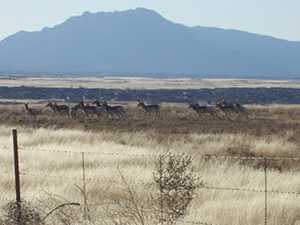
Sonoran Pronghorn Antelope (Gary Every photo)
By Gary Every
Special to the Nugget
I was in Mexico, on the edge of the Gran Desierto when 14 antelope went racing across the desert plains. The antelope were faster than the truck as the poor truck tried to traverse the bumpy, bumpy road. These were Sonoran pronghorns a slightly smaller subspecies than what lives on the rest of the continent but from what I could tell they were every bit as swift. Antelope can fly, running a mile in a little more than two minutes. Back in the Ice Age there was a prehistoric cheetah who used to run around North America and that is why the antelopes had to be so fast. The cheetahs went extinct thousands of years ago but the antelope are still fast.
The Gran Desierto antelope, all 14 of them run together, leaping sagebrush and the bizarre multitheaded barrel cactus which hug the ground there. The tiny antelope are so fast and all turn so sharply, not quite in unison, some of them stumbling. They run just a few steps in the new direction before they turn again and double back in their original direction. Our small caravan of trucks rumbles across the desert, dust kicking up as we leave the antelope behind us. We are headed towards Crater Elegante, an ancient extinct volcano whose crater stretches two miles across. Once the Crater Elegante weather gauge went seven years without rain. This part of Mexico is among the driest deserts in the world. The tall steep mountains to the west block off the rain. The earth is parched here. Volcanic cinder cones dot the landscape. Sand dunes drift here and there, piling up wherever the wind pushes them. Twisted stone, black and red lava flows, frozen in mid wave, look like craggy coral reefs, and stretch across the sandy landscape for miles and miles. The Native Americans who lived in this sparse, harsh landscape, the Hia C’ed O’odham, had a reputation as sorcerers.
This is the home of the Sonoran pronghorn. Fourteen members of this rare subspecies run alongside the truck. A few days later I return home to the Unites States and read the newspaper. I am surprised by a headline which declares that the Sonoran pronghorn is in danger of going extinct. There may be only 500 or 600 Sonoran pronghorn left in the world and I have just seen 14 of them running together. I still remember the very first time I ever saw a Sonoran pronghorn.
I was driving along a bumpy dirt road (as if there was any other kind) in the Cabeza Prieta Wilderness, just barely on the Arizona side of the Mexican border, when a future ghost suddenly burst across the road. It was an antelope who suddenly exploded from the grass, ran alongside my truck for several strides before turning sharply into the desert, disappearing in a flash. The small population of Sonoran pronghorns is divided evenly between The Gran Desierto of Sonora, Mexico and the Cabeza Prieta Wilderness Refuge and Bombing Range. The government conducted a scientific study to determine if the military exercises being conducted on the bombing range were harming the shy swift herbivores. What they discovered in this driest of deserts is that the bomb craters left behind by the military exercises tend to collect rainwater and that these miniature ponds in the middle of this brutal desert give the antelope more waterholes and make them less susceptible to ambush predators.
This nearly extinct species of antelope, this future ghost, bursts from the grass and races along side the truck. A stand of tall grass is a lush place in the desert and I know this spot where the antelope emerges is a prehistoric Hohokam charco. The Hohokam were a farming culture amidst all this cactus. They were led by a cult of astronomer priests who migrated up from Mexico. The specialty of these astronomer priests was the building of canals to harvest rainwater. The ground here is littered with brightly painted pottery shards a thousand years old or more. More recently, until about the middle of the 20th century, an old shaman brujo named Jose Juan used to live here. According to reports he was a hundred and twenty years old or more. They say that Jose Juan was the very last wizard who was able to bring the blessed rain, armed only with a bighorn sheep skull, some wine, and a song.
This dry, dry desert is famous for its graves. The 49ers sometimes used it as a dangerous shortcut to the gold fields of California. Sometimes they died of thirst along the side of the road, broken wagons and lonely graves lining the path. The conquistadors named this road the Camino Diablo or Devil’s Highway. A variety of ancient archeological artifacts cover the ground, pottery shards and projectile points, representing the O’odham, Salado, Hohokam, Cochise and Clovis cultures going all the way back to the mammoth hunters.
Unfortunately none of this archeological stuff can be carbon dated accurately because there is so much background radiation that they get dates from the far distant future. Most people suspect that our own government was using the bombing range to test low yield nuclear bombs during the 1950s and 1960s. Which our military denies, claiming it is fallout from tests conducted by the evil Soviets. I have another theory, believing that the ancient Hohokam possessed time travel technology bringing these ancient future artifacts here to warn us of the environmental apocalypse which awaits us. A rare Sonoran pronghorn races alongside me, a subspecies which my grandchildren will never see, a future ghost blessed with lightning speed, as my truck rolls and bumps over the road, internal combustion gasoline engine chugging along, clouds of dust rising up behind.

